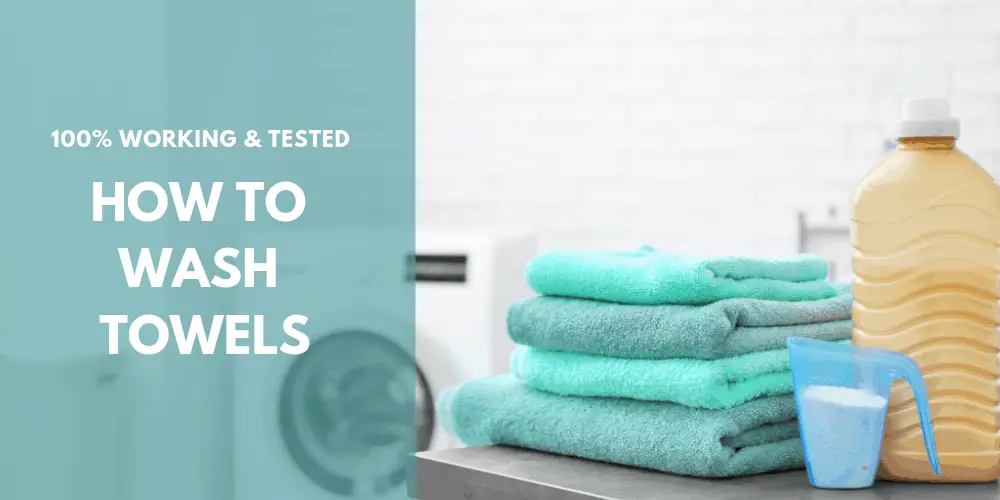Guess what – there is a “correct” way to wash towels!
I know, this sounds dumb. I mean, what is there to be correct about? You just stock a pile of towels and throw them in the washing machine. After a pre-set time, you take them out, dry (if necessary) and reuse. Simple as it sounds!
Well, if you want the towels to be durable and fresh as new every time you use them (even after several washes), then there is a “correct” way to wash towels.

But before you continue on to learn the steps to getting clean and fresh towels after every wash, you need to know the right time to wash them. It is of the utmost importance to wash and dry bath towels before you use them for the first time. Most of the towels that we buy from stores have silicones adhered to them, which block the ability to absorb. Manufactures use a coating of silicone to make them look extra fluffy and have a store-like feel. Therefore, washing the towel before using them removes the excess silicone and promotes greater absorbency.
The next question you may ask is, “How often?”
Stop thinking about the frequency of washing, and wash your towel every time you feel like it’s necessary. On a standard note, it is advised that you wash towels every 3 to 4 days.
Now, with all these ideas in your head, the next important thing to know is how to wash the towels. Here you will find two ways to wash towels. That is, through the washing machine or by hand. Take a look if you want to become a pro at cleaning towels!
Cleaning Towels in The Washing Machine
- When you are washing a towel, wash it with other towels. If you wash it with other clothes, there is a high chance that the towel will turn into a static magnet.
- You use towels to clean different sort of things. Plus, there are varieties of towels; some are used for the bath and some for sanitary reasons. All these towels carry different sort of bacteria and germs. Therefore, you should take some time and separate these before you throw your towels into the machine. Doing this will reduce the chances of the cross-contamination of dust and debris during the cleaning process. Just think: you are mixing the bathroom towel with the kitchen cleaning towel. The kitchen cleaning towel leaves oil and stickiness in the cleaning process and can get stuck to the bathroom towel. So, separate the towels before cleaning them in the washing machine.
- It is also advised to separate towels by color. For example, white towels should be washed completely separate from colored towels, to avoid any sort of discoloration. Another advantage of separating towels is that damp towels take more time to try than clothes. Separate your loads to prevent problems later.
- The temperature of the water matters when you are cleaning these dirty towels. Experts say that at 140 degrees Fahrenheit, most germs and microorganisms can be killed. When you are washing towels in the washing machine, select hot or sanitize to ensure the proper cleaning of the cloth.
- The type of detergent you are using is extremely important. If you are planning on using generic laundry detergent, this will result in the improper cleaning of your towels. To achieve the best result, invest in detergents that are specifically designed for the towels. These sorts of detergents keep towels soft and plush. However, keep the proportion of detergent small so that it gets rinsed completely and without any residue. For white towels, use non-chlorine bleach if necessary.
- Just a small word of caution: Avoid using fabric softener, or any chemicals that make towels smell fresh. Remember, this clogs the pores of towels, which attracts dust and debris. It also blocks the towel’s ability to absorb liquid. It basically hampers the purposes of using a towel.
However, if you really want something extra, you can add 1/4th cup of white vinegar to the machine to set the color of the towel and help remove any excess detergent residue. - When you are done cleaning, dry the towels on low to medium to kill any germs or bacteria that are left after washing. Drying them fully is mandatory. Remember, even a slightly damp towel can quickly grow mildew. However, you should avoid over drying, as it spoils the pattern of individual cotton fibers.
- When you are taking the towels out of the machine, give them a good shake. This will enhance the absorbency by fluffing the terry loops. This also helps to prevent the towel from turning into a ball in the dryer. Avoid ironing them with the highest heat as this fries the polyester in the towel. This leaves the towel feels crusty, hard and stiff.
Cleaning Towels by Hand:
If you want to clean the towels by hand, trust me, this is the most straightforward way to clean them. All you will need is water and towel-specialized detergent, however, if you can use lukewarm water, that is even better. Mix the detergent with the warm water (not hot) and soak the towels and cloths in the warm water for at least 30 minutes. Use your hand to rub and separate the dirt and grime from the towels. You will see the debris slowly coming out of the cloth. Wash it with water until you see clear water from it. Hang it in an open space to let it air dry.
Final Words
With all of these pro tips, it would be a crime if you spoil the towel for the sake of washing it. The purpose of this article was to give you some ideas to get your towels feeling and looking like new even after you have washed them fifty times.
Next time you are washing your towels, make sure you incorporate these. Who doesn’t like the feeling of crisp, fresh towel every time you use it?
